BULAW3731 Taxation Law: Uber and Traditional Taxi Comparison
VerifiedAdded on 2022/11/13
|14
|3659
|351
Report
AI Summary
This report examines the taxation law surrounding the sharing economy, specifically comparing the business models and tax implications of Uber and traditional taxi services. It begins with an overview of the black and sharing economies, highlighting the challenges faced by governments and tax administrations. The report then delves into detailed analyses of the Uber and traditional taxi business models, identifying key differences that impact tax outcomes. These differences include regulatory frameworks, tax breaks, and the classification of workers. The study further explores tax consequences under existing Australian tax law, addressing issues like income tax, GST, and the potential for unfair competitive advantages. The report emphasizes the need for specific regulations within the sharing economy to ensure fair competition and adequate tax collection. The report concludes by summarizing the key findings and implications for the future of taxation in the digital age.
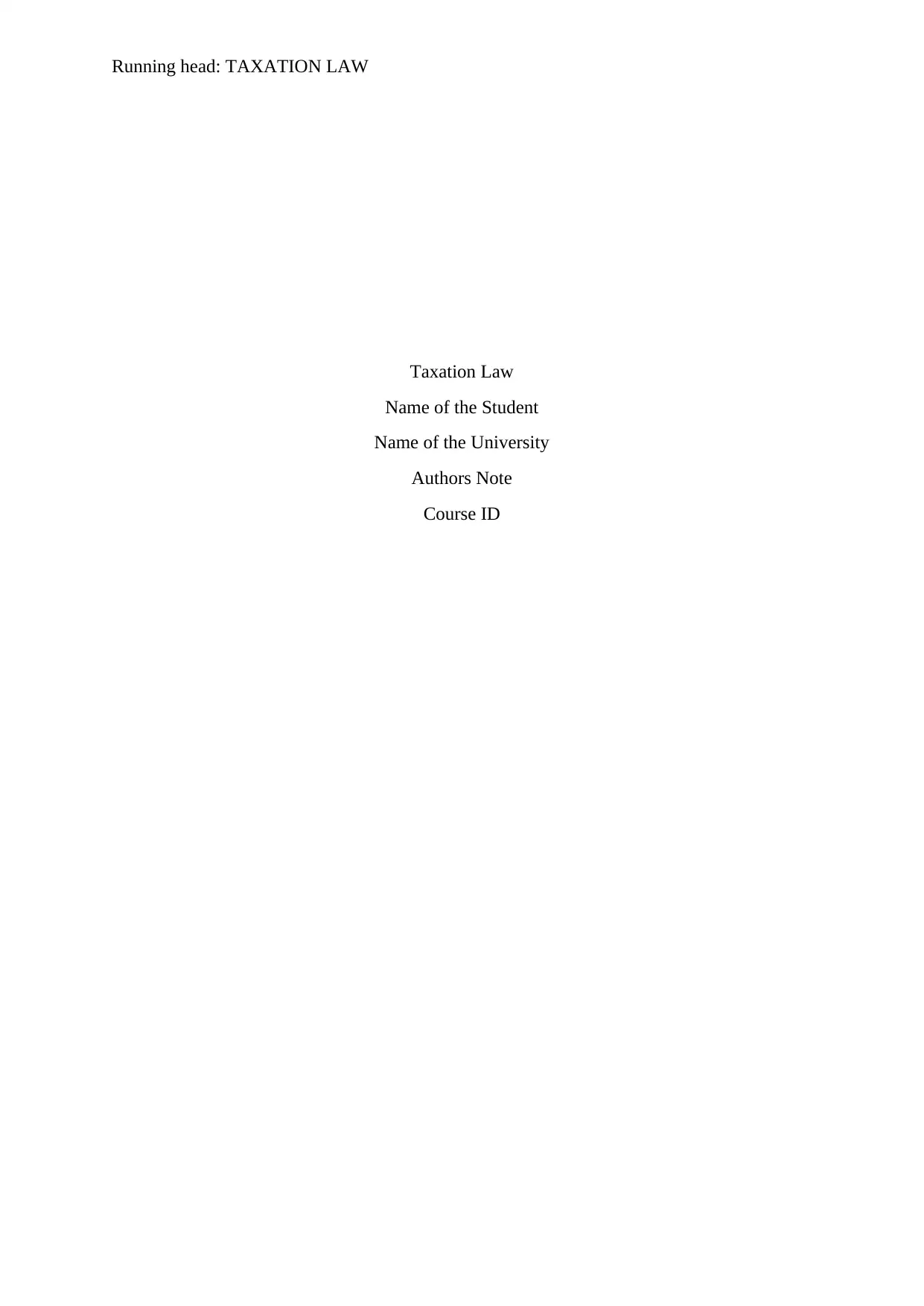
Running head: TAXATION LAW
Taxation Law
Name of the Student
Name of the University
Authors Note
Course ID
Taxation Law
Name of the Student
Name of the University
Authors Note
Course ID
Paraphrase This Document
Need a fresh take? Get an instant paraphrase of this document with our AI Paraphraser
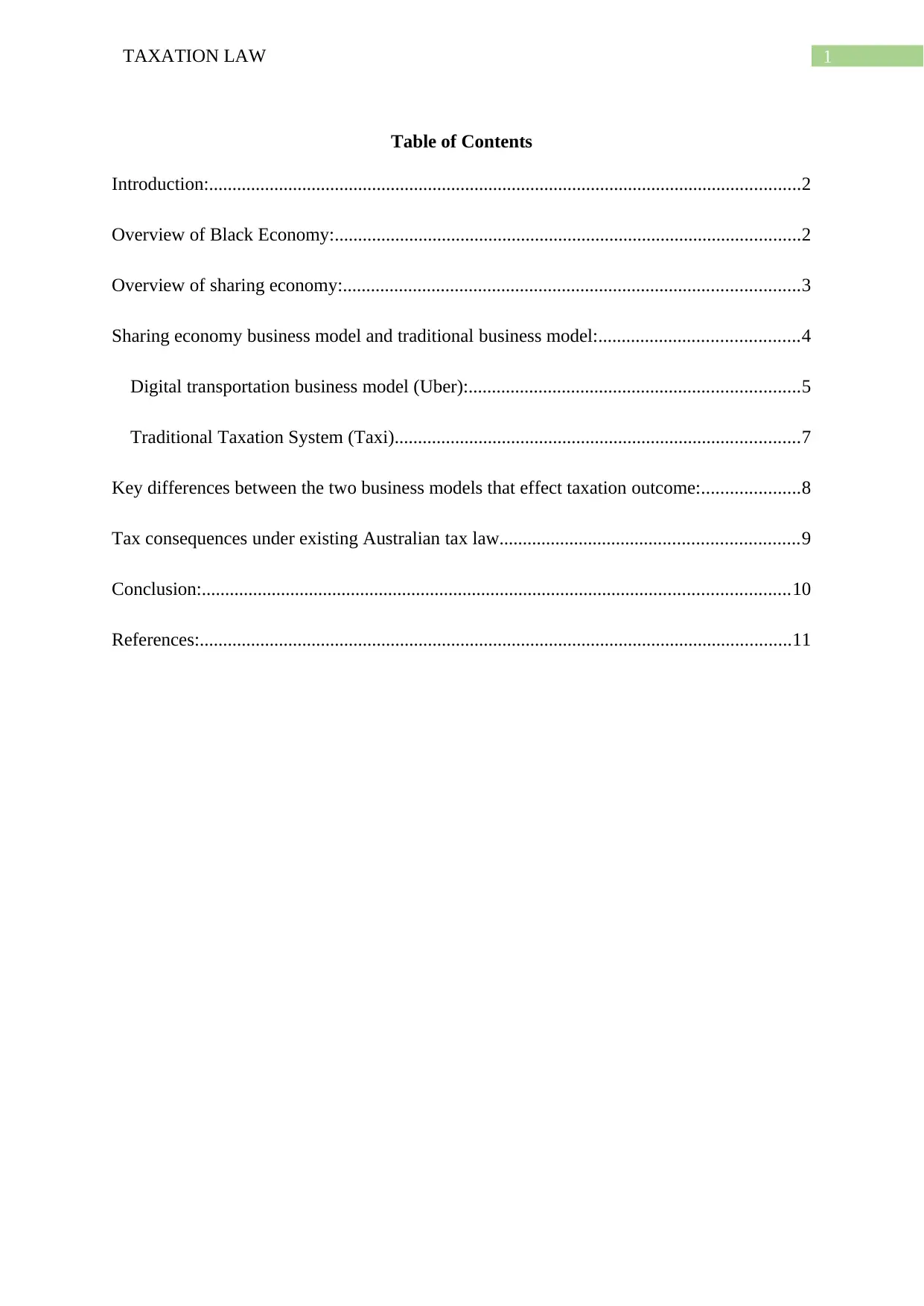
1TAXATION LAW
Table of Contents
Introduction:...............................................................................................................................2
Overview of Black Economy:....................................................................................................2
Overview of sharing economy:..................................................................................................3
Sharing economy business model and traditional business model:...........................................4
Digital transportation business model (Uber):.......................................................................5
Traditional Taxation System (Taxi).......................................................................................7
Key differences between the two business models that effect taxation outcome:.....................8
Tax consequences under existing Australian tax law................................................................9
Conclusion:..............................................................................................................................10
References:...............................................................................................................................11
Table of Contents
Introduction:...............................................................................................................................2
Overview of Black Economy:....................................................................................................2
Overview of sharing economy:..................................................................................................3
Sharing economy business model and traditional business model:...........................................4
Digital transportation business model (Uber):.......................................................................5
Traditional Taxation System (Taxi).......................................................................................7
Key differences between the two business models that effect taxation outcome:.....................8
Tax consequences under existing Australian tax law................................................................9
Conclusion:..............................................................................................................................10
References:...............................................................................................................................11
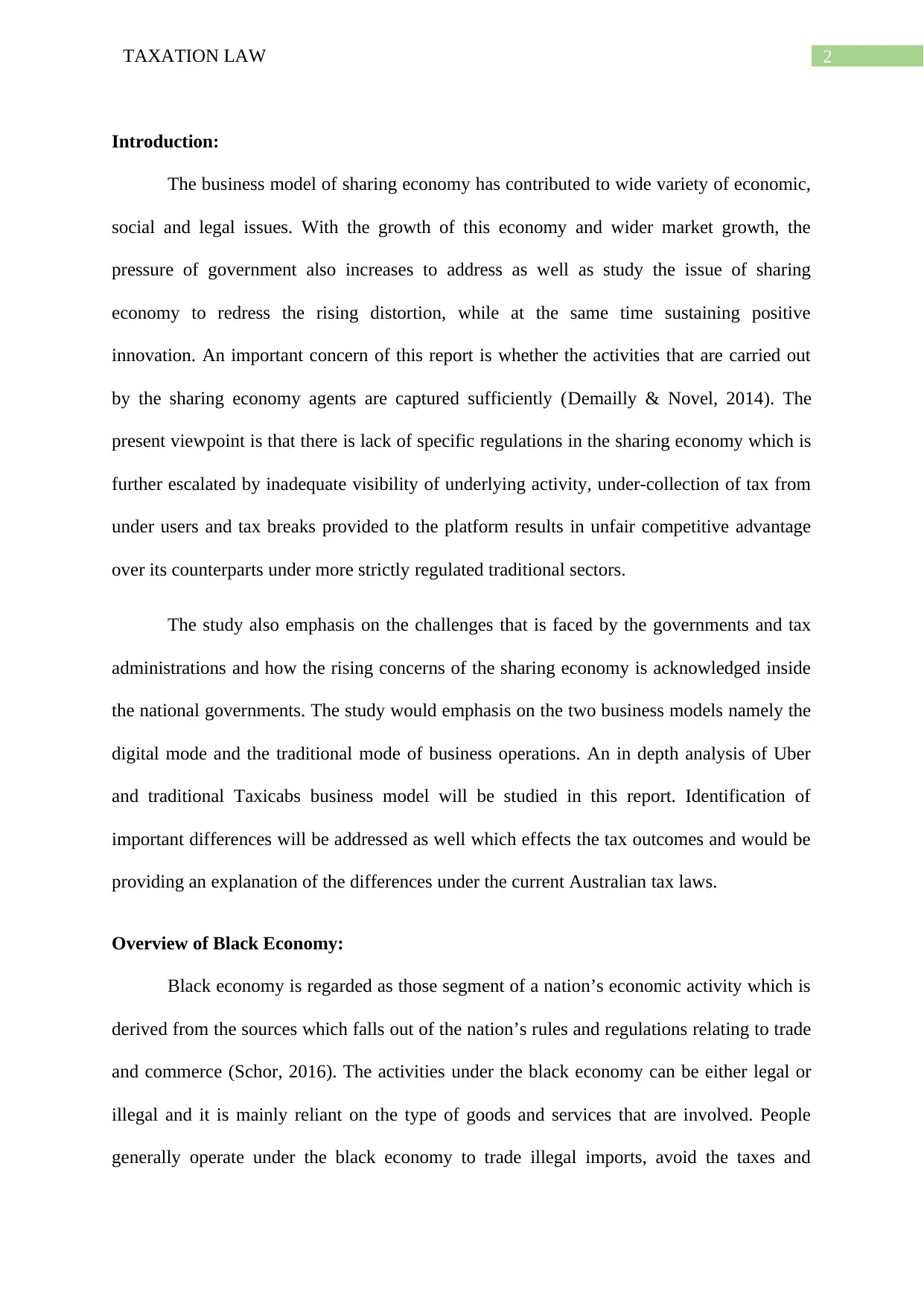
2TAXATION LAW
Introduction:
The business model of sharing economy has contributed to wide variety of economic,
social and legal issues. With the growth of this economy and wider market growth, the
pressure of government also increases to address as well as study the issue of sharing
economy to redress the rising distortion, while at the same time sustaining positive
innovation. An important concern of this report is whether the activities that are carried out
by the sharing economy agents are captured sufficiently (Demailly & Novel, 2014). The
present viewpoint is that there is lack of specific regulations in the sharing economy which is
further escalated by inadequate visibility of underlying activity, under-collection of tax from
under users and tax breaks provided to the platform results in unfair competitive advantage
over its counterparts under more strictly regulated traditional sectors.
The study also emphasis on the challenges that is faced by the governments and tax
administrations and how the rising concerns of the sharing economy is acknowledged inside
the national governments. The study would emphasis on the two business models namely the
digital mode and the traditional mode of business operations. An in depth analysis of Uber
and traditional Taxicabs business model will be studied in this report. Identification of
important differences will be addressed as well which effects the tax outcomes and would be
providing an explanation of the differences under the current Australian tax laws.
Overview of Black Economy:
Black economy is regarded as those segment of a nation’s economic activity which is
derived from the sources which falls out of the nation’s rules and regulations relating to trade
and commerce (Schor, 2016). The activities under the black economy can be either legal or
illegal and it is mainly reliant on the type of goods and services that are involved. People
generally operate under the black economy to trade illegal imports, avoid the taxes and
Introduction:
The business model of sharing economy has contributed to wide variety of economic,
social and legal issues. With the growth of this economy and wider market growth, the
pressure of government also increases to address as well as study the issue of sharing
economy to redress the rising distortion, while at the same time sustaining positive
innovation. An important concern of this report is whether the activities that are carried out
by the sharing economy agents are captured sufficiently (Demailly & Novel, 2014). The
present viewpoint is that there is lack of specific regulations in the sharing economy which is
further escalated by inadequate visibility of underlying activity, under-collection of tax from
under users and tax breaks provided to the platform results in unfair competitive advantage
over its counterparts under more strictly regulated traditional sectors.
The study also emphasis on the challenges that is faced by the governments and tax
administrations and how the rising concerns of the sharing economy is acknowledged inside
the national governments. The study would emphasis on the two business models namely the
digital mode and the traditional mode of business operations. An in depth analysis of Uber
and traditional Taxicabs business model will be studied in this report. Identification of
important differences will be addressed as well which effects the tax outcomes and would be
providing an explanation of the differences under the current Australian tax laws.
Overview of Black Economy:
Black economy is regarded as those segment of a nation’s economic activity which is
derived from the sources which falls out of the nation’s rules and regulations relating to trade
and commerce (Schor, 2016). The activities under the black economy can be either legal or
illegal and it is mainly reliant on the type of goods and services that are involved. People
generally operate under the black economy to trade illegal imports, avoid the taxes and
⊘ This is a preview!⊘
Do you want full access?
Subscribe today to unlock all pages.

Trusted by 1+ million students worldwide
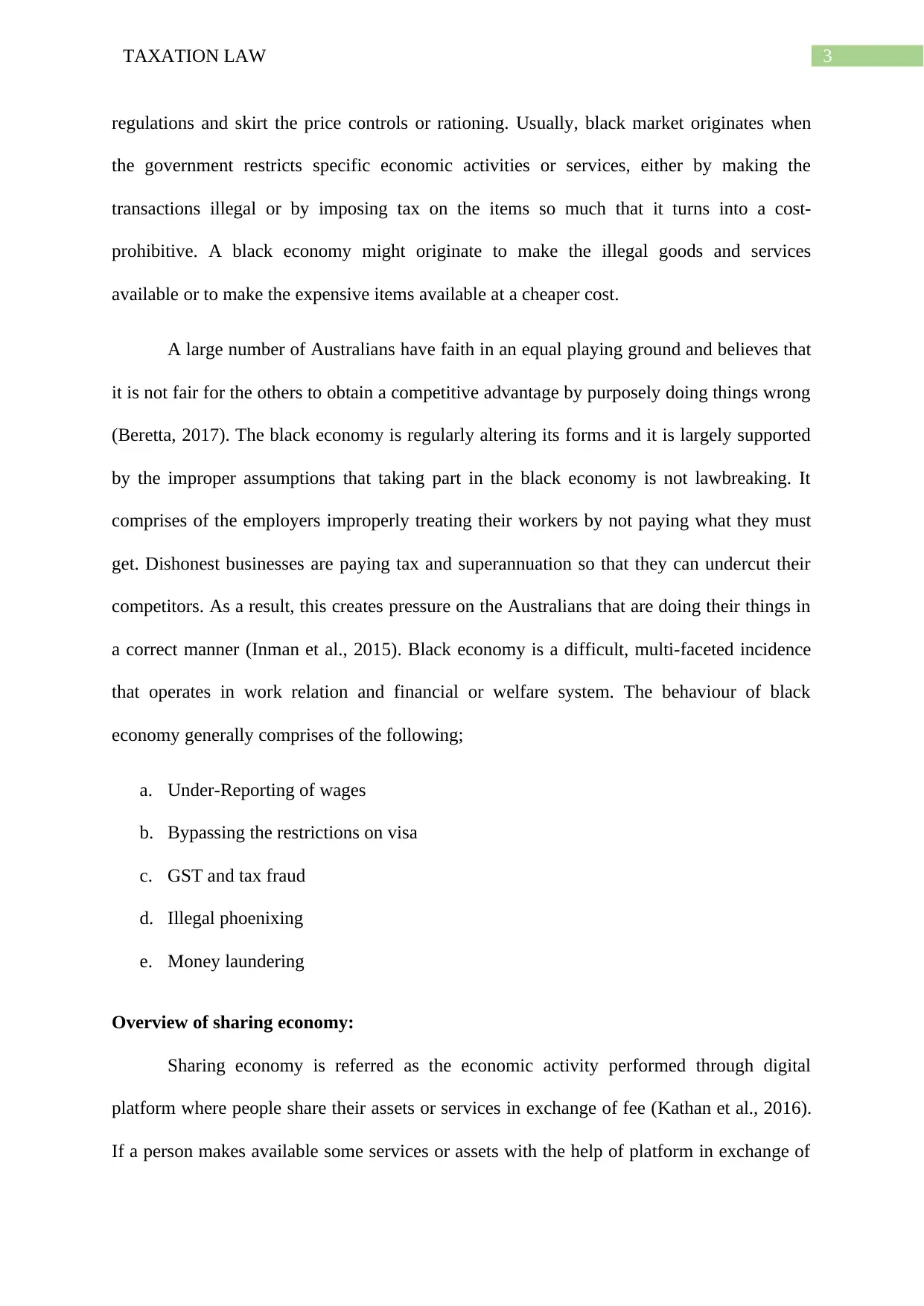
3TAXATION LAW
regulations and skirt the price controls or rationing. Usually, black market originates when
the government restricts specific economic activities or services, either by making the
transactions illegal or by imposing tax on the items so much that it turns into a cost-
prohibitive. A black economy might originate to make the illegal goods and services
available or to make the expensive items available at a cheaper cost.
A large number of Australians have faith in an equal playing ground and believes that
it is not fair for the others to obtain a competitive advantage by purposely doing things wrong
(Beretta, 2017). The black economy is regularly altering its forms and it is largely supported
by the improper assumptions that taking part in the black economy is not lawbreaking. It
comprises of the employers improperly treating their workers by not paying what they must
get. Dishonest businesses are paying tax and superannuation so that they can undercut their
competitors. As a result, this creates pressure on the Australians that are doing their things in
a correct manner (Inman et al., 2015). Black economy is a difficult, multi-faceted incidence
that operates in work relation and financial or welfare system. The behaviour of black
economy generally comprises of the following;
a. Under-Reporting of wages
b. Bypassing the restrictions on visa
c. GST and tax fraud
d. Illegal phoenixing
e. Money laundering
Overview of sharing economy:
Sharing economy is referred as the economic activity performed through digital
platform where people share their assets or services in exchange of fee (Kathan et al., 2016).
If a person makes available some services or assets with the help of platform in exchange of
regulations and skirt the price controls or rationing. Usually, black market originates when
the government restricts specific economic activities or services, either by making the
transactions illegal or by imposing tax on the items so much that it turns into a cost-
prohibitive. A black economy might originate to make the illegal goods and services
available or to make the expensive items available at a cheaper cost.
A large number of Australians have faith in an equal playing ground and believes that
it is not fair for the others to obtain a competitive advantage by purposely doing things wrong
(Beretta, 2017). The black economy is regularly altering its forms and it is largely supported
by the improper assumptions that taking part in the black economy is not lawbreaking. It
comprises of the employers improperly treating their workers by not paying what they must
get. Dishonest businesses are paying tax and superannuation so that they can undercut their
competitors. As a result, this creates pressure on the Australians that are doing their things in
a correct manner (Inman et al., 2015). Black economy is a difficult, multi-faceted incidence
that operates in work relation and financial or welfare system. The behaviour of black
economy generally comprises of the following;
a. Under-Reporting of wages
b. Bypassing the restrictions on visa
c. GST and tax fraud
d. Illegal phoenixing
e. Money laundering
Overview of sharing economy:
Sharing economy is referred as the economic activity performed through digital
platform where people share their assets or services in exchange of fee (Kathan et al., 2016).
If a person makes available some services or assets with the help of platform in exchange of
Paraphrase This Document
Need a fresh take? Get an instant paraphrase of this document with our AI Paraphraser
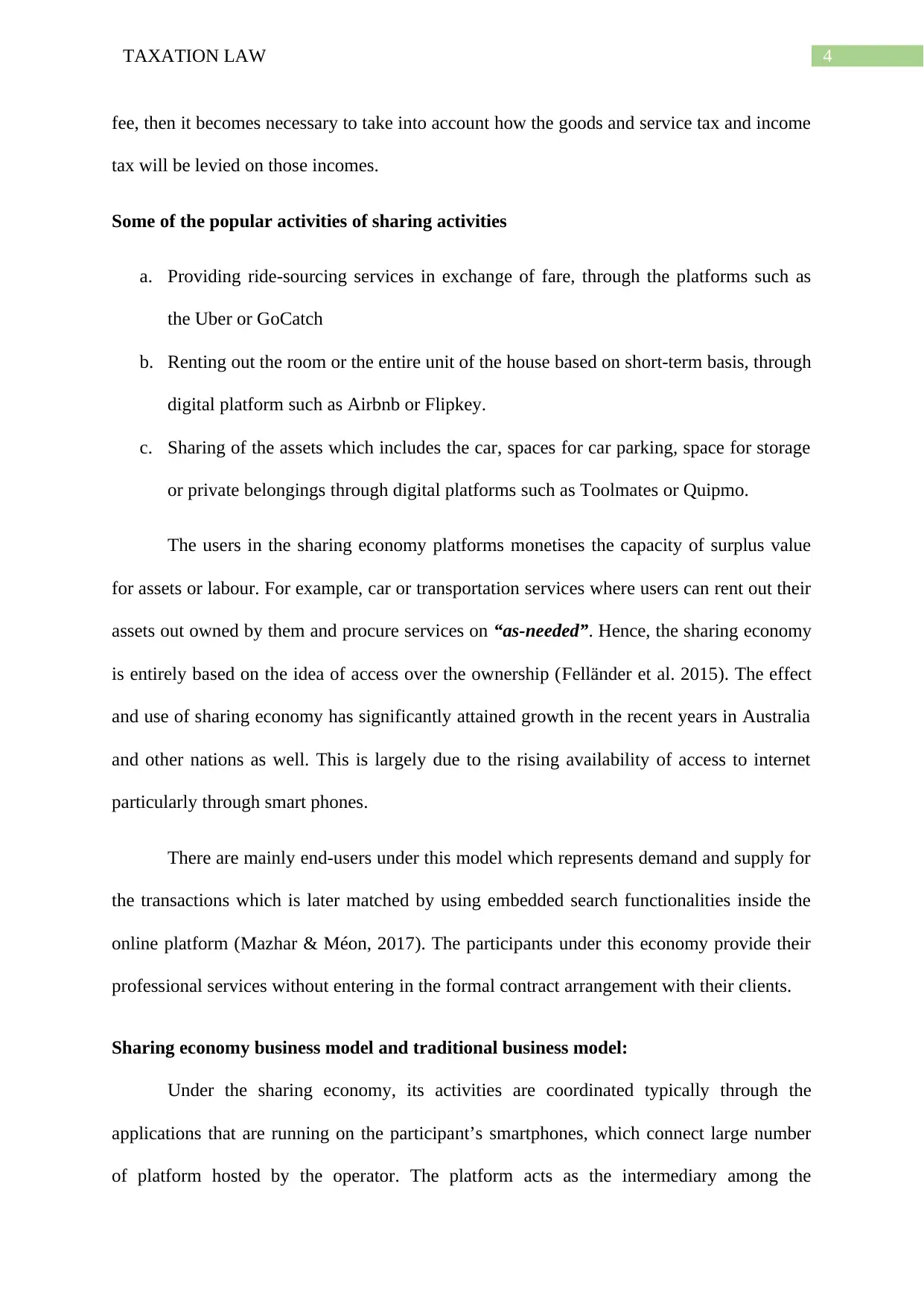
4TAXATION LAW
fee, then it becomes necessary to take into account how the goods and service tax and income
tax will be levied on those incomes.
Some of the popular activities of sharing activities
a. Providing ride-sourcing services in exchange of fare, through the platforms such as
the Uber or GoCatch
b. Renting out the room or the entire unit of the house based on short-term basis, through
digital platform such as Airbnb or Flipkey.
c. Sharing of the assets which includes the car, spaces for car parking, space for storage
or private belongings through digital platforms such as Toolmates or Quipmo.
The users in the sharing economy platforms monetises the capacity of surplus value
for assets or labour. For example, car or transportation services where users can rent out their
assets out owned by them and procure services on “as-needed”. Hence, the sharing economy
is entirely based on the idea of access over the ownership (Felländer et al. 2015). The effect
and use of sharing economy has significantly attained growth in the recent years in Australia
and other nations as well. This is largely due to the rising availability of access to internet
particularly through smart phones.
There are mainly end-users under this model which represents demand and supply for
the transactions which is later matched by using embedded search functionalities inside the
online platform (Mazhar & Méon, 2017). The participants under this economy provide their
professional services without entering in the formal contract arrangement with their clients.
Sharing economy business model and traditional business model:
Under the sharing economy, its activities are coordinated typically through the
applications that are running on the participant’s smartphones, which connect large number
of platform hosted by the operator. The platform acts as the intermediary among the
fee, then it becomes necessary to take into account how the goods and service tax and income
tax will be levied on those incomes.
Some of the popular activities of sharing activities
a. Providing ride-sourcing services in exchange of fare, through the platforms such as
the Uber or GoCatch
b. Renting out the room or the entire unit of the house based on short-term basis, through
digital platform such as Airbnb or Flipkey.
c. Sharing of the assets which includes the car, spaces for car parking, space for storage
or private belongings through digital platforms such as Toolmates or Quipmo.
The users in the sharing economy platforms monetises the capacity of surplus value
for assets or labour. For example, car or transportation services where users can rent out their
assets out owned by them and procure services on “as-needed”. Hence, the sharing economy
is entirely based on the idea of access over the ownership (Felländer et al. 2015). The effect
and use of sharing economy has significantly attained growth in the recent years in Australia
and other nations as well. This is largely due to the rising availability of access to internet
particularly through smart phones.
There are mainly end-users under this model which represents demand and supply for
the transactions which is later matched by using embedded search functionalities inside the
online platform (Mazhar & Méon, 2017). The participants under this economy provide their
professional services without entering in the formal contract arrangement with their clients.
Sharing economy business model and traditional business model:
Under the sharing economy, its activities are coordinated typically through the
applications that are running on the participant’s smartphones, which connect large number
of platform hosted by the operator. The platform acts as the intermediary among the
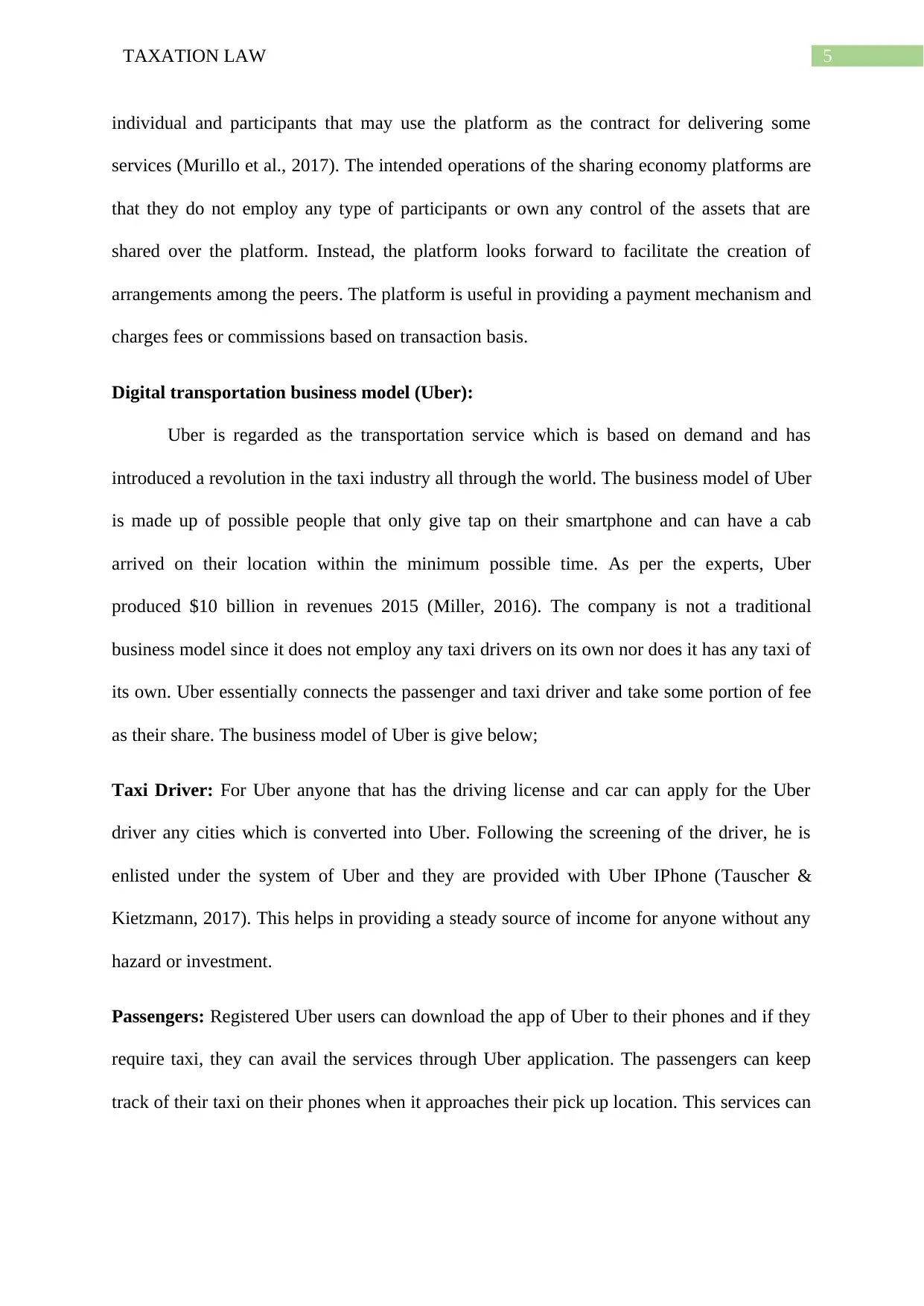
5TAXATION LAW
individual and participants that may use the platform as the contract for delivering some
services (Murillo et al., 2017). The intended operations of the sharing economy platforms are
that they do not employ any type of participants or own any control of the assets that are
shared over the platform. Instead, the platform looks forward to facilitate the creation of
arrangements among the peers. The platform is useful in providing a payment mechanism and
charges fees or commissions based on transaction basis.
Digital transportation business model (Uber):
Uber is regarded as the transportation service which is based on demand and has
introduced a revolution in the taxi industry all through the world. The business model of Uber
is made up of possible people that only give tap on their smartphone and can have a cab
arrived on their location within the minimum possible time. As per the experts, Uber
produced $10 billion in revenues 2015 (Miller, 2016). The company is not a traditional
business model since it does not employ any taxi drivers on its own nor does it has any taxi of
its own. Uber essentially connects the passenger and taxi driver and take some portion of fee
as their share. The business model of Uber is give below;
Taxi Driver: For Uber anyone that has the driving license and car can apply for the Uber
driver any cities which is converted into Uber. Following the screening of the driver, he is
enlisted under the system of Uber and they are provided with Uber IPhone (Tauscher &
Kietzmann, 2017). This helps in providing a steady source of income for anyone without any
hazard or investment.
Passengers: Registered Uber users can download the app of Uber to their phones and if they
require taxi, they can avail the services through Uber application. The passengers can keep
track of their taxi on their phones when it approaches their pick up location. This services can
individual and participants that may use the platform as the contract for delivering some
services (Murillo et al., 2017). The intended operations of the sharing economy platforms are
that they do not employ any type of participants or own any control of the assets that are
shared over the platform. Instead, the platform looks forward to facilitate the creation of
arrangements among the peers. The platform is useful in providing a payment mechanism and
charges fees or commissions based on transaction basis.
Digital transportation business model (Uber):
Uber is regarded as the transportation service which is based on demand and has
introduced a revolution in the taxi industry all through the world. The business model of Uber
is made up of possible people that only give tap on their smartphone and can have a cab
arrived on their location within the minimum possible time. As per the experts, Uber
produced $10 billion in revenues 2015 (Miller, 2016). The company is not a traditional
business model since it does not employ any taxi drivers on its own nor does it has any taxi of
its own. Uber essentially connects the passenger and taxi driver and take some portion of fee
as their share. The business model of Uber is give below;
Taxi Driver: For Uber anyone that has the driving license and car can apply for the Uber
driver any cities which is converted into Uber. Following the screening of the driver, he is
enlisted under the system of Uber and they are provided with Uber IPhone (Tauscher &
Kietzmann, 2017). This helps in providing a steady source of income for anyone without any
hazard or investment.
Passengers: Registered Uber users can download the app of Uber to their phones and if they
require taxi, they can avail the services through Uber application. The passengers can keep
track of their taxi on their phones when it approaches their pick up location. This services can
⊘ This is a preview!⊘
Do you want full access?
Subscribe today to unlock all pages.

Trusted by 1+ million students worldwide
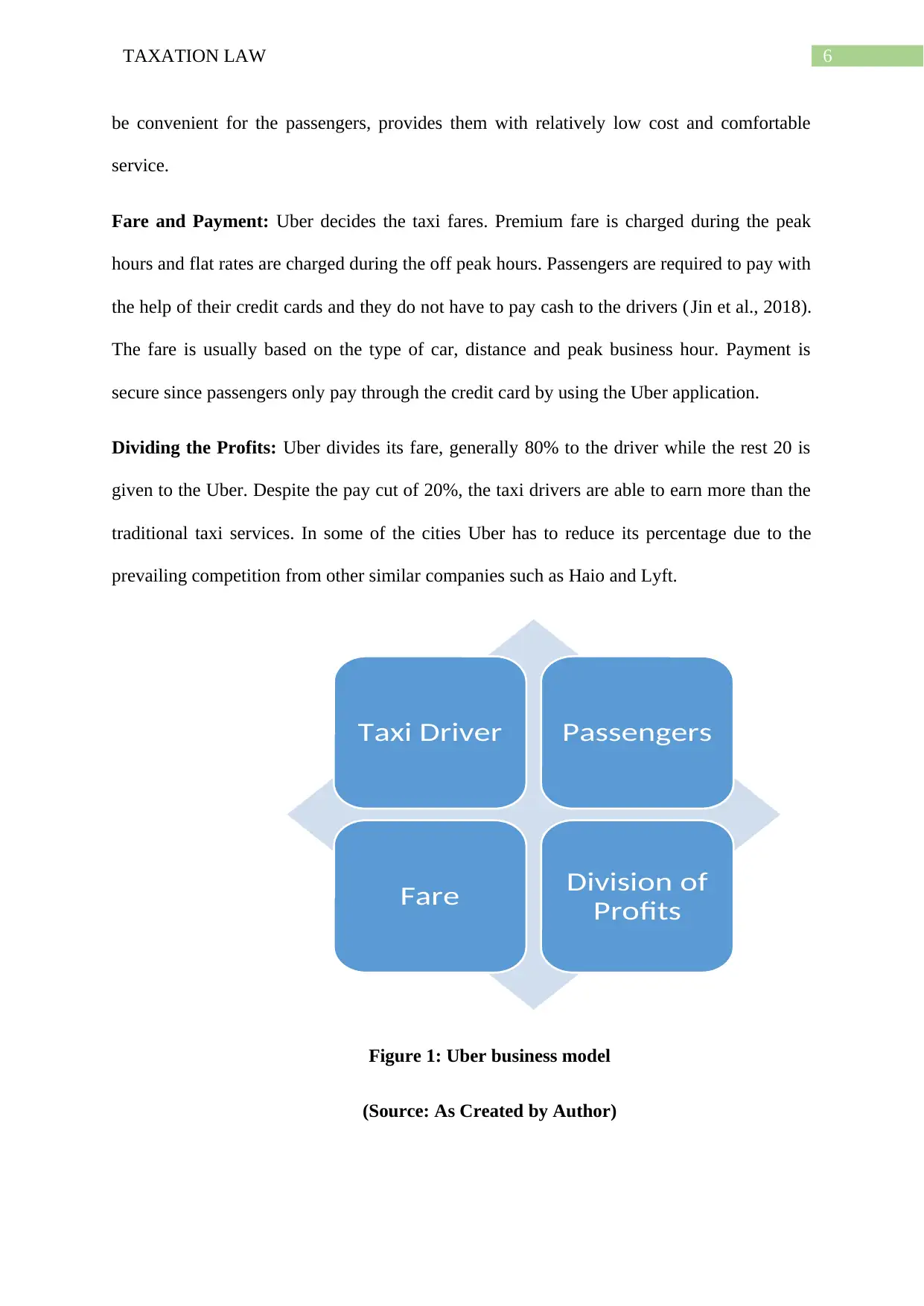
6TAXATION LAW
be convenient for the passengers, provides them with relatively low cost and comfortable
service.
Fare and Payment: Uber decides the taxi fares. Premium fare is charged during the peak
hours and flat rates are charged during the off peak hours. Passengers are required to pay with
the help of their credit cards and they do not have to pay cash to the drivers (Jin et al., 2018).
The fare is usually based on the type of car, distance and peak business hour. Payment is
secure since passengers only pay through the credit card by using the Uber application.
Dividing the Profits: Uber divides its fare, generally 80% to the driver while the rest 20 is
given to the Uber. Despite the pay cut of 20%, the taxi drivers are able to earn more than the
traditional taxi services. In some of the cities Uber has to reduce its percentage due to the
prevailing competition from other similar companies such as Haio and Lyft.
Figure 1: Uber business model
(Source: As Created by Author)
Taxi Driver Passengers
Fare Division of
Profits
be convenient for the passengers, provides them with relatively low cost and comfortable
service.
Fare and Payment: Uber decides the taxi fares. Premium fare is charged during the peak
hours and flat rates are charged during the off peak hours. Passengers are required to pay with
the help of their credit cards and they do not have to pay cash to the drivers (Jin et al., 2018).
The fare is usually based on the type of car, distance and peak business hour. Payment is
secure since passengers only pay through the credit card by using the Uber application.
Dividing the Profits: Uber divides its fare, generally 80% to the driver while the rest 20 is
given to the Uber. Despite the pay cut of 20%, the taxi drivers are able to earn more than the
traditional taxi services. In some of the cities Uber has to reduce its percentage due to the
prevailing competition from other similar companies such as Haio and Lyft.
Figure 1: Uber business model
(Source: As Created by Author)
Taxi Driver Passengers
Fare Division of
Profits
Paraphrase This Document
Need a fresh take? Get an instant paraphrase of this document with our AI Paraphraser
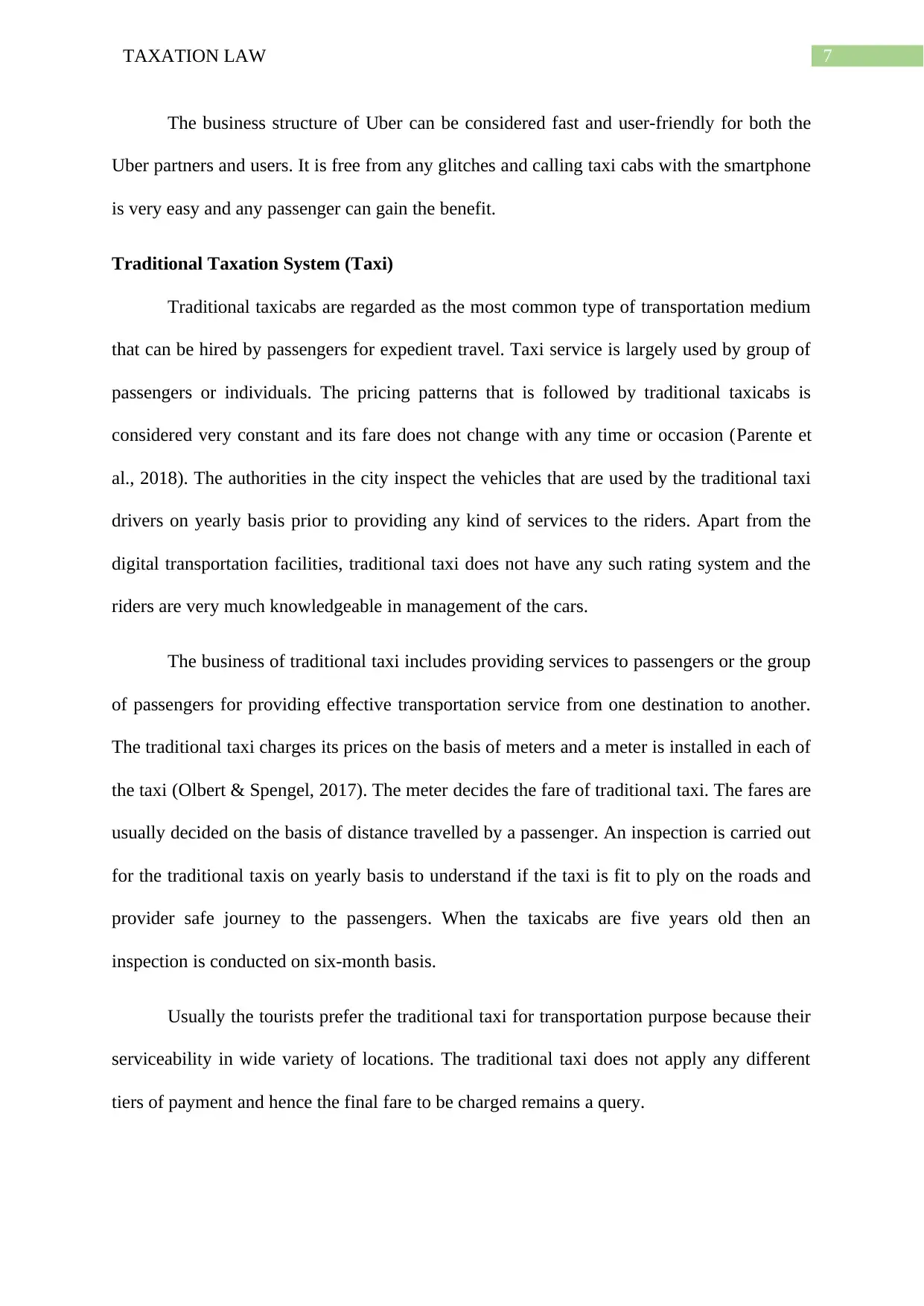
7TAXATION LAW
The business structure of Uber can be considered fast and user-friendly for both the
Uber partners and users. It is free from any glitches and calling taxi cabs with the smartphone
is very easy and any passenger can gain the benefit.
Traditional Taxation System (Taxi)
Traditional taxicabs are regarded as the most common type of transportation medium
that can be hired by passengers for expedient travel. Taxi service is largely used by group of
passengers or individuals. The pricing patterns that is followed by traditional taxicabs is
considered very constant and its fare does not change with any time or occasion (Parente et
al., 2018). The authorities in the city inspect the vehicles that are used by the traditional taxi
drivers on yearly basis prior to providing any kind of services to the riders. Apart from the
digital transportation facilities, traditional taxi does not have any such rating system and the
riders are very much knowledgeable in management of the cars.
The business of traditional taxi includes providing services to passengers or the group
of passengers for providing effective transportation service from one destination to another.
The traditional taxi charges its prices on the basis of meters and a meter is installed in each of
the taxi (Olbert & Spengel, 2017). The meter decides the fare of traditional taxi. The fares are
usually decided on the basis of distance travelled by a passenger. An inspection is carried out
for the traditional taxis on yearly basis to understand if the taxi is fit to ply on the roads and
provider safe journey to the passengers. When the taxicabs are five years old then an
inspection is conducted on six-month basis.
Usually the tourists prefer the traditional taxi for transportation purpose because their
serviceability in wide variety of locations. The traditional taxi does not apply any different
tiers of payment and hence the final fare to be charged remains a query.
The business structure of Uber can be considered fast and user-friendly for both the
Uber partners and users. It is free from any glitches and calling taxi cabs with the smartphone
is very easy and any passenger can gain the benefit.
Traditional Taxation System (Taxi)
Traditional taxicabs are regarded as the most common type of transportation medium
that can be hired by passengers for expedient travel. Taxi service is largely used by group of
passengers or individuals. The pricing patterns that is followed by traditional taxicabs is
considered very constant and its fare does not change with any time or occasion (Parente et
al., 2018). The authorities in the city inspect the vehicles that are used by the traditional taxi
drivers on yearly basis prior to providing any kind of services to the riders. Apart from the
digital transportation facilities, traditional taxi does not have any such rating system and the
riders are very much knowledgeable in management of the cars.
The business of traditional taxi includes providing services to passengers or the group
of passengers for providing effective transportation service from one destination to another.
The traditional taxi charges its prices on the basis of meters and a meter is installed in each of
the taxi (Olbert & Spengel, 2017). The meter decides the fare of traditional taxi. The fares are
usually decided on the basis of distance travelled by a passenger. An inspection is carried out
for the traditional taxis on yearly basis to understand if the taxi is fit to ply on the roads and
provider safe journey to the passengers. When the taxicabs are five years old then an
inspection is conducted on six-month basis.
Usually the tourists prefer the traditional taxi for transportation purpose because their
serviceability in wide variety of locations. The traditional taxi does not apply any different
tiers of payment and hence the final fare to be charged remains a query.
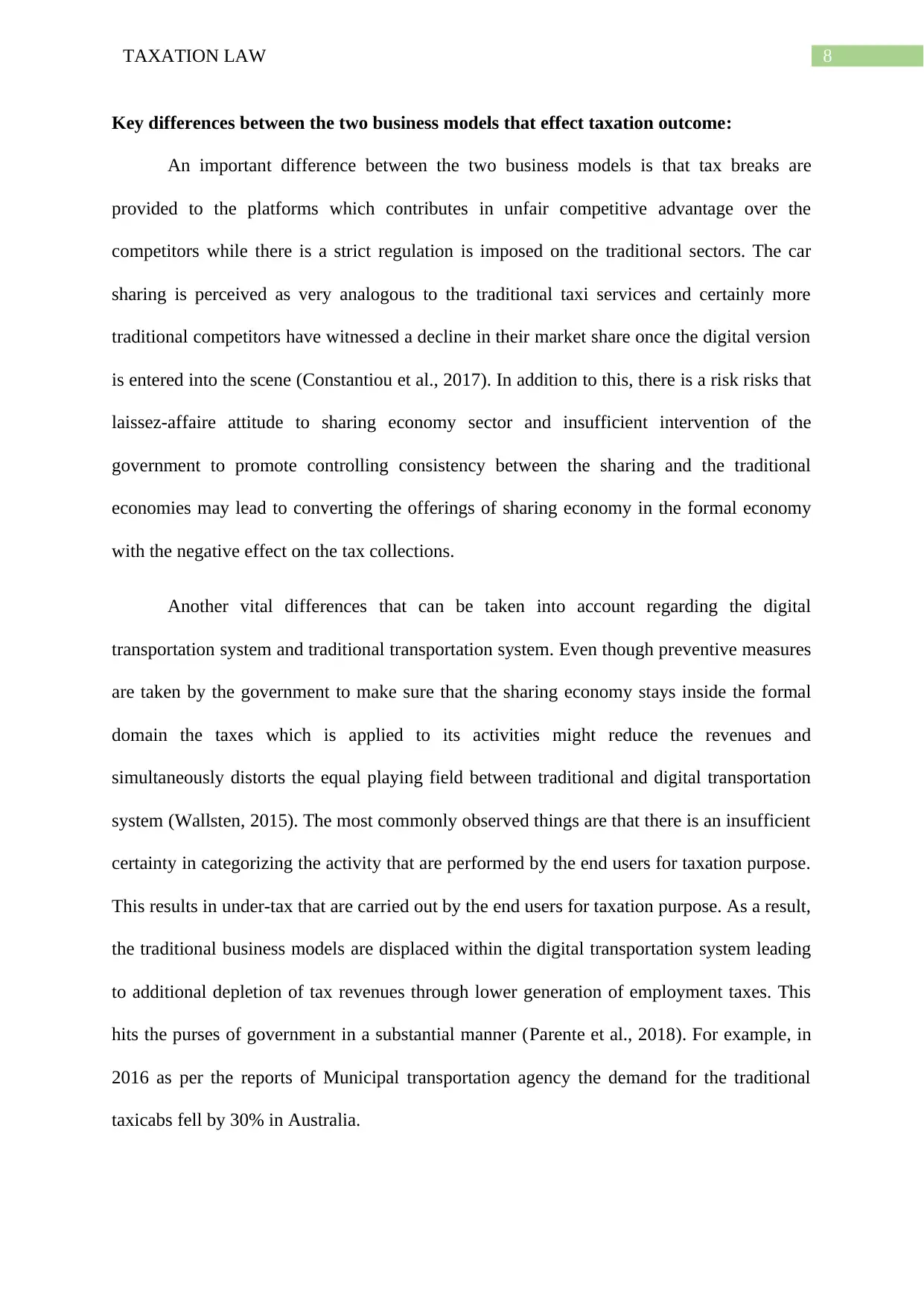
8TAXATION LAW
Key differences between the two business models that effect taxation outcome:
An important difference between the two business models is that tax breaks are
provided to the platforms which contributes in unfair competitive advantage over the
competitors while there is a strict regulation is imposed on the traditional sectors. The car
sharing is perceived as very analogous to the traditional taxi services and certainly more
traditional competitors have witnessed a decline in their market share once the digital version
is entered into the scene (Constantiou et al., 2017). In addition to this, there is a risk risks that
laissez-affaire attitude to sharing economy sector and insufficient intervention of the
government to promote controlling consistency between the sharing and the traditional
economies may lead to converting the offerings of sharing economy in the formal economy
with the negative effect on the tax collections.
Another vital differences that can be taken into account regarding the digital
transportation system and traditional transportation system. Even though preventive measures
are taken by the government to make sure that the sharing economy stays inside the formal
domain the taxes which is applied to its activities might reduce the revenues and
simultaneously distorts the equal playing field between traditional and digital transportation
system (Wallsten, 2015). The most commonly observed things are that there is an insufficient
certainty in categorizing the activity that are performed by the end users for taxation purpose.
This results in under-tax that are carried out by the end users for taxation purpose. As a result,
the traditional business models are displaced within the digital transportation system leading
to additional depletion of tax revenues through lower generation of employment taxes. This
hits the purses of government in a substantial manner (Parente et al., 2018). For example, in
2016 as per the reports of Municipal transportation agency the demand for the traditional
taxicabs fell by 30% in Australia.
Key differences between the two business models that effect taxation outcome:
An important difference between the two business models is that tax breaks are
provided to the platforms which contributes in unfair competitive advantage over the
competitors while there is a strict regulation is imposed on the traditional sectors. The car
sharing is perceived as very analogous to the traditional taxi services and certainly more
traditional competitors have witnessed a decline in their market share once the digital version
is entered into the scene (Constantiou et al., 2017). In addition to this, there is a risk risks that
laissez-affaire attitude to sharing economy sector and insufficient intervention of the
government to promote controlling consistency between the sharing and the traditional
economies may lead to converting the offerings of sharing economy in the formal economy
with the negative effect on the tax collections.
Another vital differences that can be taken into account regarding the digital
transportation system and traditional transportation system. Even though preventive measures
are taken by the government to make sure that the sharing economy stays inside the formal
domain the taxes which is applied to its activities might reduce the revenues and
simultaneously distorts the equal playing field between traditional and digital transportation
system (Wallsten, 2015). The most commonly observed things are that there is an insufficient
certainty in categorizing the activity that are performed by the end users for taxation purpose.
This results in under-tax that are carried out by the end users for taxation purpose. As a result,
the traditional business models are displaced within the digital transportation system leading
to additional depletion of tax revenues through lower generation of employment taxes. This
hits the purses of government in a substantial manner (Parente et al., 2018). For example, in
2016 as per the reports of Municipal transportation agency the demand for the traditional
taxicabs fell by 30% in Australia.
⊘ This is a preview!⊘
Do you want full access?
Subscribe today to unlock all pages.

Trusted by 1+ million students worldwide
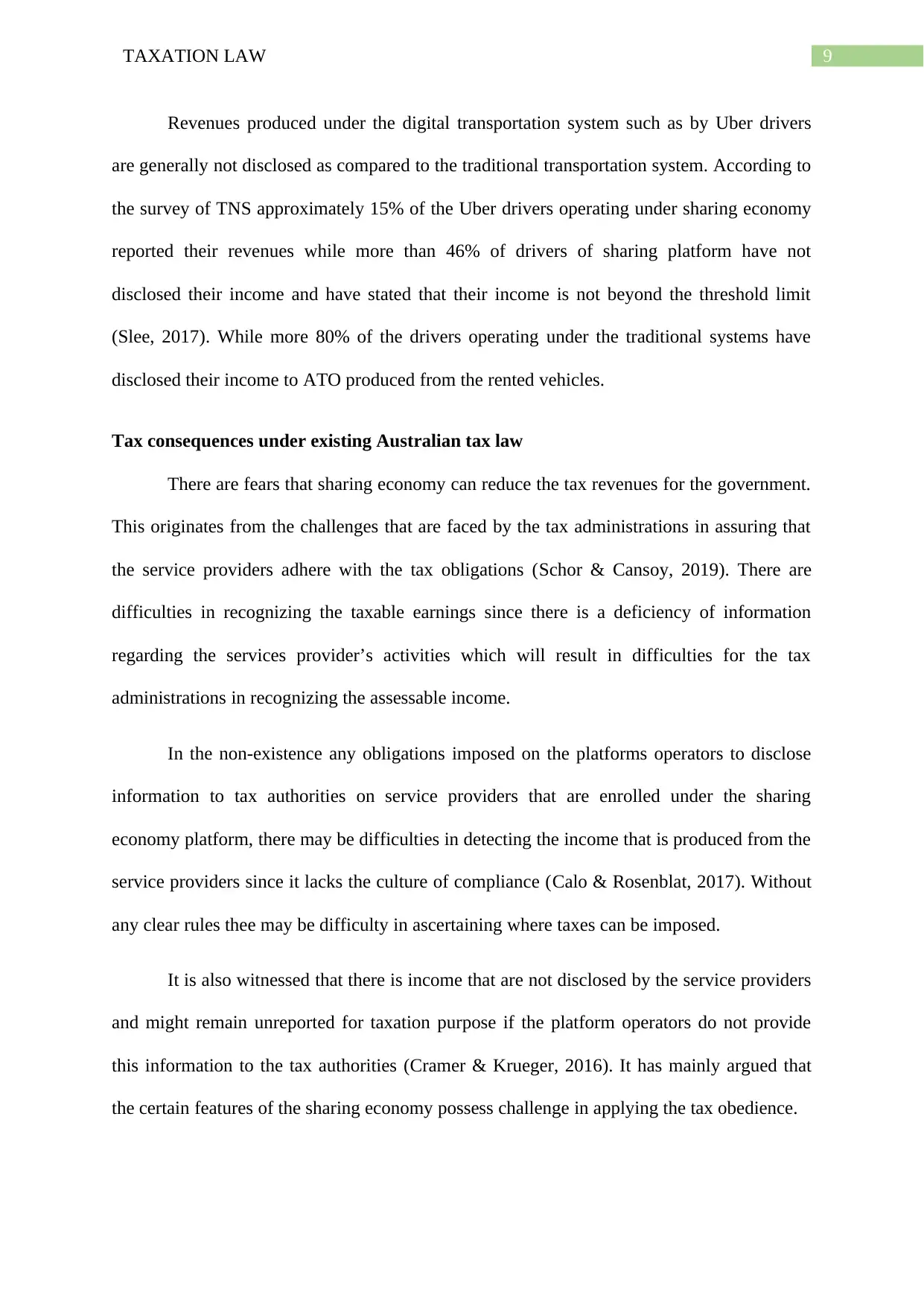
9TAXATION LAW
Revenues produced under the digital transportation system such as by Uber drivers
are generally not disclosed as compared to the traditional transportation system. According to
the survey of TNS approximately 15% of the Uber drivers operating under sharing economy
reported their revenues while more than 46% of drivers of sharing platform have not
disclosed their income and have stated that their income is not beyond the threshold limit
(Slee, 2017). While more 80% of the drivers operating under the traditional systems have
disclosed their income to ATO produced from the rented vehicles.
Tax consequences under existing Australian tax law
There are fears that sharing economy can reduce the tax revenues for the government.
This originates from the challenges that are faced by the tax administrations in assuring that
the service providers adhere with the tax obligations (Schor & Cansoy, 2019). There are
difficulties in recognizing the taxable earnings since there is a deficiency of information
regarding the services provider’s activities which will result in difficulties for the tax
administrations in recognizing the assessable income.
In the non-existence any obligations imposed on the platforms operators to disclose
information to tax authorities on service providers that are enrolled under the sharing
economy platform, there may be difficulties in detecting the income that is produced from the
service providers since it lacks the culture of compliance (Calo & Rosenblat, 2017). Without
any clear rules thee may be difficulty in ascertaining where taxes can be imposed.
It is also witnessed that there is income that are not disclosed by the service providers
and might remain unreported for taxation purpose if the platform operators do not provide
this information to the tax authorities (Cramer & Krueger, 2016). It has mainly argued that
the certain features of the sharing economy possess challenge in applying the tax obedience.
Revenues produced under the digital transportation system such as by Uber drivers
are generally not disclosed as compared to the traditional transportation system. According to
the survey of TNS approximately 15% of the Uber drivers operating under sharing economy
reported their revenues while more than 46% of drivers of sharing platform have not
disclosed their income and have stated that their income is not beyond the threshold limit
(Slee, 2017). While more 80% of the drivers operating under the traditional systems have
disclosed their income to ATO produced from the rented vehicles.
Tax consequences under existing Australian tax law
There are fears that sharing economy can reduce the tax revenues for the government.
This originates from the challenges that are faced by the tax administrations in assuring that
the service providers adhere with the tax obligations (Schor & Cansoy, 2019). There are
difficulties in recognizing the taxable earnings since there is a deficiency of information
regarding the services provider’s activities which will result in difficulties for the tax
administrations in recognizing the assessable income.
In the non-existence any obligations imposed on the platforms operators to disclose
information to tax authorities on service providers that are enrolled under the sharing
economy platform, there may be difficulties in detecting the income that is produced from the
service providers since it lacks the culture of compliance (Calo & Rosenblat, 2017). Without
any clear rules thee may be difficulty in ascertaining where taxes can be imposed.
It is also witnessed that there is income that are not disclosed by the service providers
and might remain unreported for taxation purpose if the platform operators do not provide
this information to the tax authorities (Cramer & Krueger, 2016). It has mainly argued that
the certain features of the sharing economy possess challenge in applying the tax obedience.
Paraphrase This Document
Need a fresh take? Get an instant paraphrase of this document with our AI Paraphraser
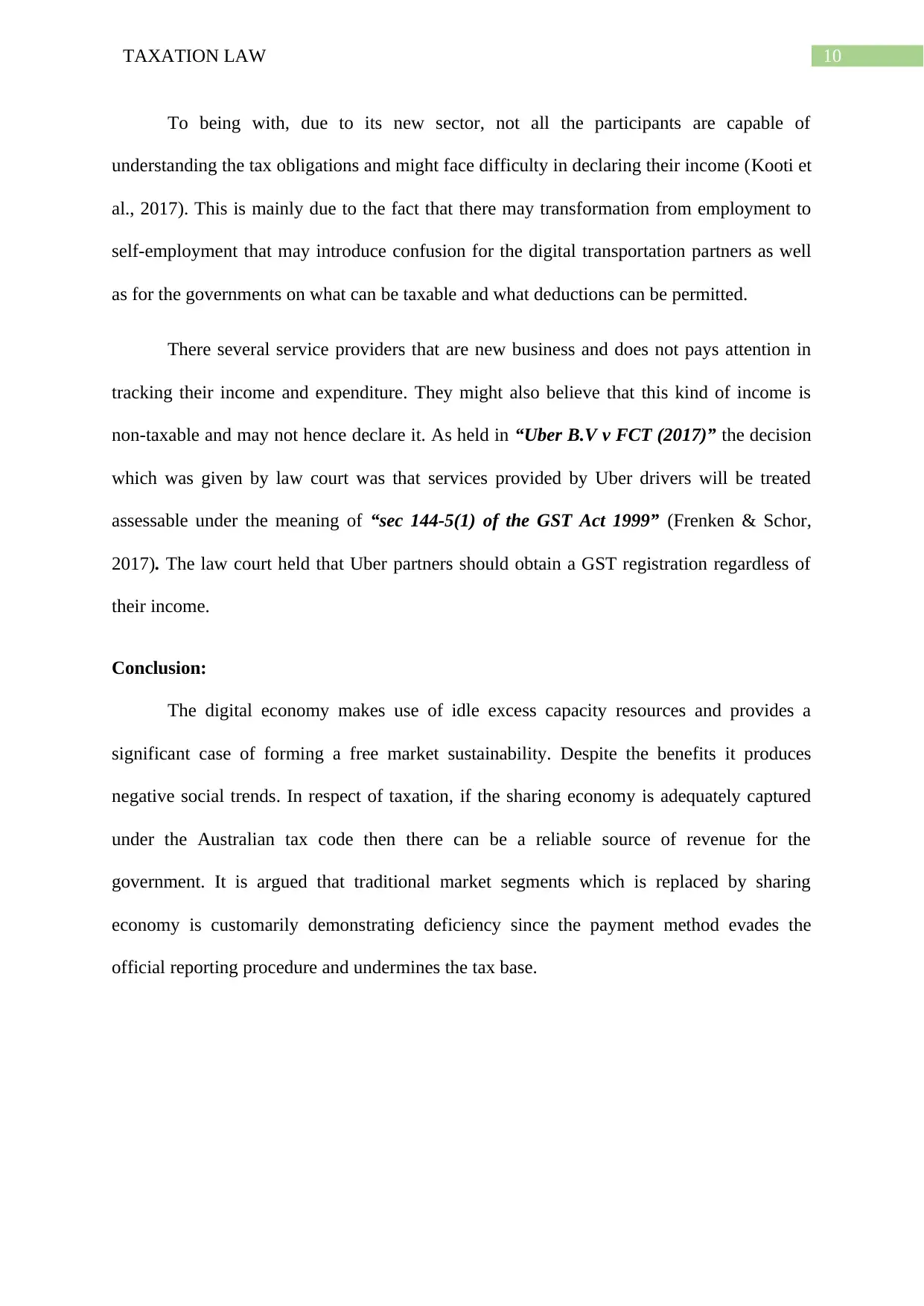
10TAXATION LAW
To being with, due to its new sector, not all the participants are capable of
understanding the tax obligations and might face difficulty in declaring their income (Kooti et
al., 2017). This is mainly due to the fact that there may transformation from employment to
self-employment that may introduce confusion for the digital transportation partners as well
as for the governments on what can be taxable and what deductions can be permitted.
There several service providers that are new business and does not pays attention in
tracking their income and expenditure. They might also believe that this kind of income is
non-taxable and may not hence declare it. As held in “Uber B.V v FCT (2017)” the decision
which was given by law court was that services provided by Uber drivers will be treated
assessable under the meaning of “sec 144-5(1) of the GST Act 1999” (Frenken & Schor,
2017). The law court held that Uber partners should obtain a GST registration regardless of
their income.
Conclusion:
The digital economy makes use of idle excess capacity resources and provides a
significant case of forming a free market sustainability. Despite the benefits it produces
negative social trends. In respect of taxation, if the sharing economy is adequately captured
under the Australian tax code then there can be a reliable source of revenue for the
government. It is argued that traditional market segments which is replaced by sharing
economy is customarily demonstrating deficiency since the payment method evades the
official reporting procedure and undermines the tax base.
To being with, due to its new sector, not all the participants are capable of
understanding the tax obligations and might face difficulty in declaring their income (Kooti et
al., 2017). This is mainly due to the fact that there may transformation from employment to
self-employment that may introduce confusion for the digital transportation partners as well
as for the governments on what can be taxable and what deductions can be permitted.
There several service providers that are new business and does not pays attention in
tracking their income and expenditure. They might also believe that this kind of income is
non-taxable and may not hence declare it. As held in “Uber B.V v FCT (2017)” the decision
which was given by law court was that services provided by Uber drivers will be treated
assessable under the meaning of “sec 144-5(1) of the GST Act 1999” (Frenken & Schor,
2017). The law court held that Uber partners should obtain a GST registration regardless of
their income.
Conclusion:
The digital economy makes use of idle excess capacity resources and provides a
significant case of forming a free market sustainability. Despite the benefits it produces
negative social trends. In respect of taxation, if the sharing economy is adequately captured
under the Australian tax code then there can be a reliable source of revenue for the
government. It is argued that traditional market segments which is replaced by sharing
economy is customarily demonstrating deficiency since the payment method evades the
official reporting procedure and undermines the tax base.
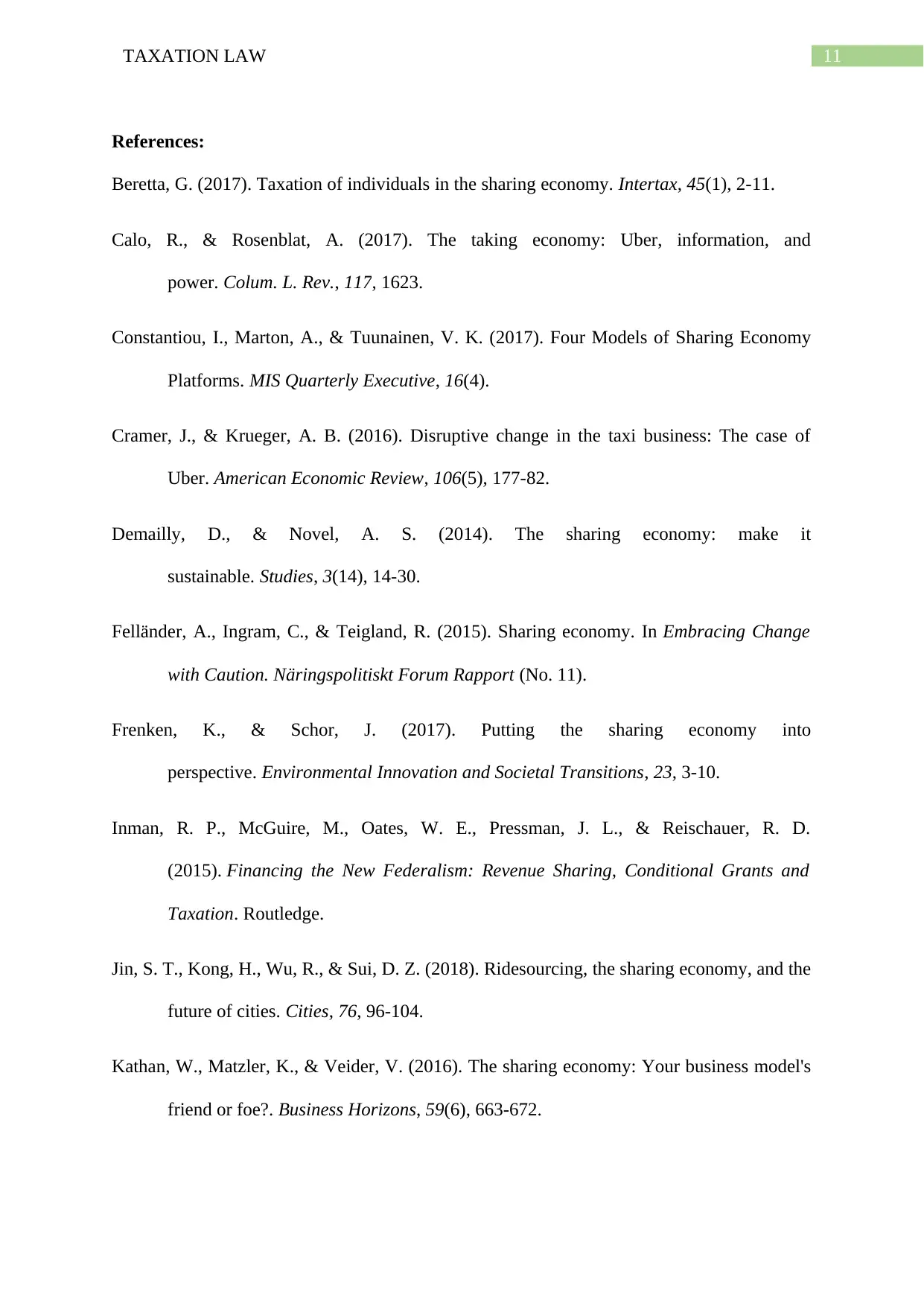
11TAXATION LAW
References:
Beretta, G. (2017). Taxation of individuals in the sharing economy. Intertax, 45(1), 2-11.
Calo, R., & Rosenblat, A. (2017). The taking economy: Uber, information, and
power. Colum. L. Rev., 117, 1623.
Constantiou, I., Marton, A., & Tuunainen, V. K. (2017). Four Models of Sharing Economy
Platforms. MIS Quarterly Executive, 16(4).
Cramer, J., & Krueger, A. B. (2016). Disruptive change in the taxi business: The case of
Uber. American Economic Review, 106(5), 177-82.
Demailly, D., & Novel, A. S. (2014). The sharing economy: make it
sustainable. Studies, 3(14), 14-30.
Felländer, A., Ingram, C., & Teigland, R. (2015). Sharing economy. In Embracing Change
with Caution. Näringspolitiskt Forum Rapport (No. 11).
Frenken, K., & Schor, J. (2017). Putting the sharing economy into
perspective. Environmental Innovation and Societal Transitions, 23, 3-10.
Inman, R. P., McGuire, M., Oates, W. E., Pressman, J. L., & Reischauer, R. D.
(2015). Financing the New Federalism: Revenue Sharing, Conditional Grants and
Taxation. Routledge.
Jin, S. T., Kong, H., Wu, R., & Sui, D. Z. (2018). Ridesourcing, the sharing economy, and the
future of cities. Cities, 76, 96-104.
Kathan, W., Matzler, K., & Veider, V. (2016). The sharing economy: Your business model's
friend or foe?. Business Horizons, 59(6), 663-672.
References:
Beretta, G. (2017). Taxation of individuals in the sharing economy. Intertax, 45(1), 2-11.
Calo, R., & Rosenblat, A. (2017). The taking economy: Uber, information, and
power. Colum. L. Rev., 117, 1623.
Constantiou, I., Marton, A., & Tuunainen, V. K. (2017). Four Models of Sharing Economy
Platforms. MIS Quarterly Executive, 16(4).
Cramer, J., & Krueger, A. B. (2016). Disruptive change in the taxi business: The case of
Uber. American Economic Review, 106(5), 177-82.
Demailly, D., & Novel, A. S. (2014). The sharing economy: make it
sustainable. Studies, 3(14), 14-30.
Felländer, A., Ingram, C., & Teigland, R. (2015). Sharing economy. In Embracing Change
with Caution. Näringspolitiskt Forum Rapport (No. 11).
Frenken, K., & Schor, J. (2017). Putting the sharing economy into
perspective. Environmental Innovation and Societal Transitions, 23, 3-10.
Inman, R. P., McGuire, M., Oates, W. E., Pressman, J. L., & Reischauer, R. D.
(2015). Financing the New Federalism: Revenue Sharing, Conditional Grants and
Taxation. Routledge.
Jin, S. T., Kong, H., Wu, R., & Sui, D. Z. (2018). Ridesourcing, the sharing economy, and the
future of cities. Cities, 76, 96-104.
Kathan, W., Matzler, K., & Veider, V. (2016). The sharing economy: Your business model's
friend or foe?. Business Horizons, 59(6), 663-672.
⊘ This is a preview!⊘
Do you want full access?
Subscribe today to unlock all pages.

Trusted by 1+ million students worldwide
1 out of 14
Related Documents
Your All-in-One AI-Powered Toolkit for Academic Success.
+13062052269
info@desklib.com
Available 24*7 on WhatsApp / Email
![[object Object]](/_next/static/media/star-bottom.7253800d.svg)
Unlock your academic potential
Copyright © 2020–2025 A2Z Services. All Rights Reserved. Developed and managed by ZUCOL.





